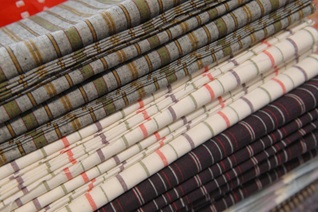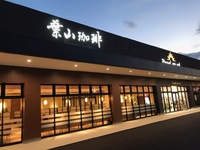
Until Ensyumentsumugi is finished

“Kaseage” (hank-winding)
Cotton yarn to be the raw material for the cotton spindle is wound into a “kase (hank),” which is a bundle of a fixed length of yarn. While careful attention is paid so as to get a neat roll, a large volume of yarn is wound manually without stopping.

“Senshoku” (dyeing)
Yarn is bleached (refining) and then dyed a specified color. The yarn is first rinsed in hot water so that vegetable fat and lye are removed, making it easier for color to penetrate the yarn. The yarn is placed in a large pot, and hot water with the dye dissolved in it is poured over the yarn.

“Norizuke” (starching)
To prevent yarn from fluffing and to facilitate weaving, starch is impregnated into the yarn. This process serves to prevent yarn from being cut due to weaving friction. While the starch is kept warm, an adequate volume of yarn is immersed in it, mixed thoroughly and evenly and slightly fanned for settling.
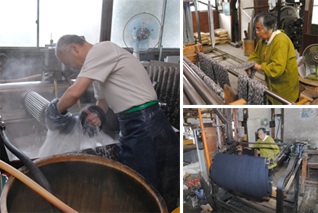
“Kudamaki” (pirn winding)
The yarn bundle is then wound onto a pirn again. The hank of yarn, after being dyed and starched, is wound into a bundle called an “imokuda” (larger pirn state). The yarn is wound with great care to prevent the yarn from getting tangled or cut.
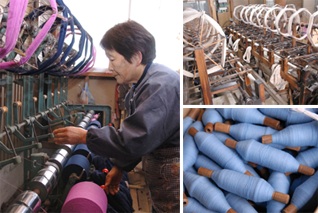
“Seikei” (warping)
Warps are aligned according to the pattern. Each pattern has its own combination of the number of yarns and colors, which is fixed by the order of alignment.

“Hetoshi” (reeding)
The yarns aligned one by one in a pattern are passed through the comb-shaped holes called a “reed”. When Hetoshi is completed, yarns are wound all at once.
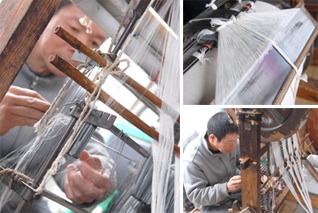
“Hataori” (weaving)
The warps are fixed on the loom, and weaving operation starts.
The final color shade depends on the colors used for the wefts. Approximately three to five tans of cloth per day (one tan is approximately 106m in length and 34cm in width) are carefully woven on the loom.

“Oriagari” (finished fabric)
This yarn is woven into Enshu Men Tsumugi through various processes. Since the Edo period, several thousands of striped patterns have been created and favored in a wide variety of forms from kimono to sundries.
